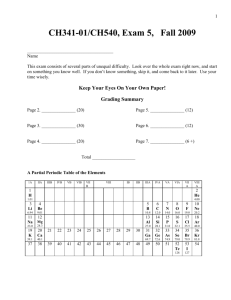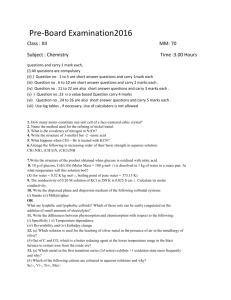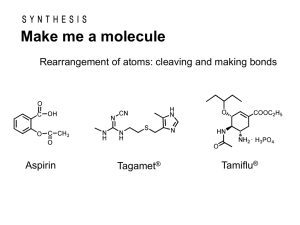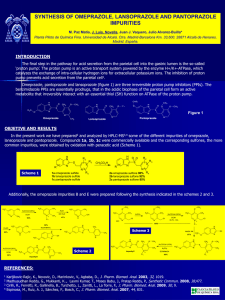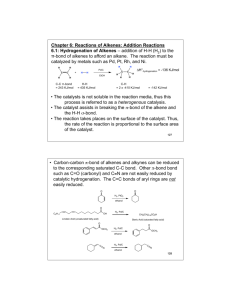File - Sydney Schramm
advertisement
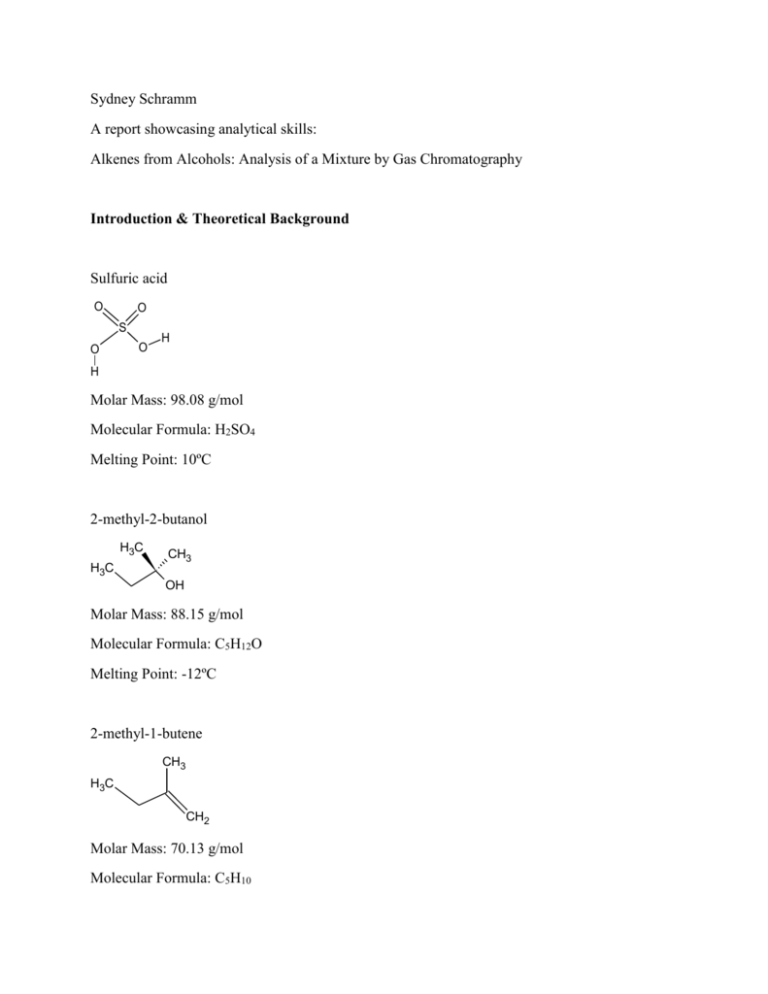
Sydney Schramm A report showcasing analytical skills: Alkenes from Alcohols: Analysis of a Mixture by Gas Chromatography Introduction & Theoretical Background Sulfuric acid O O S O O H H Molar Mass: 98.08 g/mol Molecular Formula: H2SO4 Melting Point: 10ºC 2-methyl-2-butanol H3C H3C CH3 OH Molar Mass: 88.15 g/mol Molecular Formula: C5H12O Melting Point: -12ºC 2-methyl-1-butene CH3 H3C CH2 Molar Mass: 70.13 g/mol Molecular Formula: C5H10 Melting Point: -137ºC 2-methyl-2-butene CH3 H3C CH3 Molar Mass: 70.13 g/mol Molecular Formula: C5H10 Melting Point: -134ºC This experiment used sulfuric acid as a catalyst and 2-methyl-2-butanol as a substrate in a dehydration reaction to give a mixture of alkenes that can be analyzed using gas chromatography. This reaction is an elimination reaction, more specifically, an E1 reaction (2). Each step of the reaction can be reversed, and different isomers can be produced by the alkene. In the reaction, involving 2-methyl-2-butanol, a stable tertiary carbocation is produced (see figure below) (1). Depending on the loss of a proton from a primary carbon or a secondary carbon, either 2-methyl-2-butene or 2-methyl-1-butene will be produced, as shown below (2). Loss of a proton from a primary carbon yields 2-methyl-1-butene and loss of a proton from a secondary carbon yields 2-methyl-2-butene (2). H3C OH H+ H2O + H3C fast CH3 H3C H2O + CH3 H3C HSO4- + H3C slow H3C CH3 + H3C + C H3C H H O CH3 H3C CH3 slow + C H3C H3C CH2 H H H 2-methyl-1-butene O CH3 H3C + C H3C CH3 slow H3C CH3 H H H 2-methyl-2-butene O E1 vs. E2 Reactions E1 E2 Rate depends upon concentration of alkyl halide (1) Rate depends upon concentration of alkyl halide and base (1) Prefers high temperatures (1) Prefers high temperatures (1) Two step unimolecular process with one transition and two intermediate states (1) One step bimolecular process with one transition state (1) Products can be determined by Zaitsev’s Rule. (1) Hydride and methyl rearrangements are impossible (1) Prefers strong base (1) Must occur with antiperiplanar stereochemistry (1) Products can be determined by Zaitsev’s Rule. (1) Hydride and methyl rearrangements are possible (1) Strong base not required (1) The reaction examined by this experiment follows Zaitsev’s rule which indicates that in an elimination reaction with a possibility of having more than one alkene product, the product with greater stability will be the major product (1). Alkenes with greater substitution are usually more stable than alkenes that are lesser substituted. Thus, as observed by this experiment, 2methyl-2-butene, which is more substituted than 2-methyl-1-butene (see structures above), will be the major product (2). The more the alkyl groups attached to the sp2 carbons, the more substituted are the alkenes (1). Conditions that favor the observance of Zaitsev’s rule is the presence of a small base; a large base will likely follow and produce the lesser substituted “Hoffman Product.” Side products may have included H2SO4, H3O+, and H2O (2) also a competing substitution reaction may have produced the following. Substitution H O CH3 H3C H CH3 H3C + C OH CH3 CH3 2-methyl-2-butanol (Start) To analyze the concentrations of the components of the solution produced by the reaction of 2-methyl-2-butanol, gas chromatography is used. It can help determine the relative amounts of different materials in a mixture or the impurities in a mixture (2). On the copy, retention time (minutes) and integral (percent area) are indicated. Higher peaks indicate a lesser volatile component, and a lower peak indicates a more volatile component (2). There is a gaseous mobile phase of helium or nitrogen; the stationary phase involves a non-volatile high boiling liquid (2). As the crude sample is injected into the apparatus, its components are separated based on temperature, polarity, and rate of gas flow (2). Experimental Detector Temperature= 25 °C Column Temperature= 44 °C Injection Temperature= 41 °C Pre-weigh Vial (in Calcium Chloride)= 23.714 Vial + Collected Material= 24.393 Theoretical yield: (1.60g 2-methyl-2-butanol) / (88.15g/mol) = .018 mol 0.018 mol x (70.13g/mol) = 1.26 g mixture Actual yield: (.679g mixture) / (88.15 g/mol) = 0.0077 mol 0.0077 mol x (70.13g/mol) = 0.5401 g mixture Percent yield = actual/theoretical x 100% = 42.87% Minor product = 9.49791% composition Major product = 90.50211% composition % yield for minor product= (.0949)( 0.0077 mol) = 0.00073 mol Mass = 0.00073 mol (70.13g/mol) = 0.051g % yield for major product is = (.9050211)( 0.0077 mol) = 0.00696 mol Mass = 0.00696 mol (70.13g/mol) = 0.488g Discussion This experiment was successful in verifying Zaitsev’s rule; 2-methyl-2-butene was produced as the major product from 2-methyl-2-butanol, as it is more substituted than the product 2-methyl-1-butene. The gas chromatography verified this. Most substituted alkenes have a transition state with a lower energy. The more substituted the product, the more stable it is and the least volatile. The lesser substituted product will be less stable and will be more volatile. The larger peak confirmed that the mixture was 90.50211% 2-methyl-2-butene, which is the more stable and most substituted alkene. The mixture also included 9.49791% 2-methyl-1butene. Possible errors include over distillation with the range of 30 to 45 degrees Celsius and not capping the product vial quickly enough; products may have evaporated leading to an incorrect yield. Another issue could have occurred when preparing the solution. If the proper measurements were not used, the process would not have been as accurate as it should have been. Also, the vial may not have been cooled in ice when mixing reagents of sulfuric acid and alcohol and after distillation; the highly volatile products may have been lost. The theoretical percentage for the collected mixture would have been 90% 2-methyl-2-butene and 10% 2methyl-1-butene. References 1. Wade, G; L. Organic Chemistry. 6th edition: Prentice Hall: New Jersey, 2006.- Organic Book 2. Weldegirma, Solomon. Experimental Organic Chemistry Laboratory Manual. Boston: Houghton Mifflin Company, 2008.




